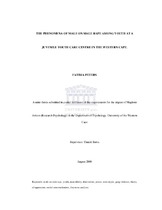| dc.contributor.advisor | Bawa, Umesh | |
| dc.contributor.author | Peters, Fatima | |
| dc.date.accessioned | 2014-07-28T11:05:14Z | |
| dc.date.available | 2014-07-28T11:05:14Z | |
| dc.date.issued | 2010 | |
| dc.identifier.uri | http://hdl.handle.net/11394/3522 | |
| dc.description | Magister Psychologiae - MPsych | en_US |
| dc.description.abstract | A concentration about issues important to the subpopulation of children in conflict with the law has received much more attention over the past few years. It is a known fact that within all male environments the likelihood of violence and especially sexual violence is exponential. Male on male rape as a topic has only received greater exposure over the last decade. Male on male rape within the context of the child and youth care context has however been reported, recorded and written about in academia to a far lesser degree.Within this research study it was found that within the child and youth care context oppressive practices of male on male rape and exploitation were rife. Life is marred by intra-personal, inter-personal and institutional violence. A hierarchy based on the ability to resort to violence and gender mitigated all experiences within this context.Through these experiences children came to understand the phenomenon of male on male rape.This research study was exploratory in nature and aimed to gain a deeper understanding of how children within this context understood and spoke about male on male rape.This endeavour was qualitative in approach and utilised social constructionism and the theory of oppression to understand the discourses produced by participants. The participants were males with age ranging from 16 to 18 years. An interview was the framework within which the phenomenon of male on male rape was discusses. The information gained from participants was managed through the use of discourse analysis. The highest ethical standards were upheld during the research process.In conclusion three main discourses were utilised by participants to make sense of the phenomenon of male on male rape. These discourses were the discourse of violence,the discourse of gang culture and the discourse of gender. These discourses intersected and predominantly functioned to hinder the reporting and likelihood of children that were sexually assaulted acquiring assistance. | en_US |
| dc.language.iso | en | en_US |
| dc.subject | Subpopulation of children | en_US |
| dc.subject | Male on male rape | en_US |
| dc.subject | Child and youth care | en_US |
| dc.title | The phenomena of male on male rape among youth at a Juvenile youth care centre in the Western Cape | en_US |
| dc.type | Thesis | en_US |

